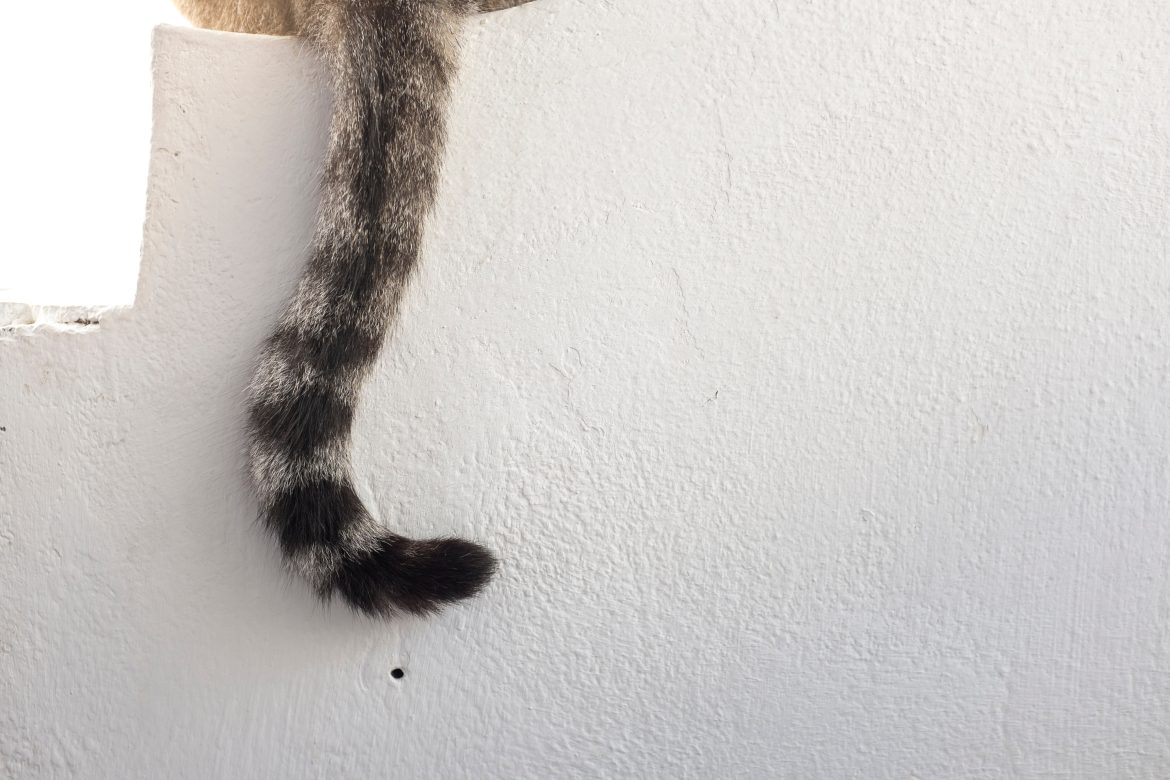While cats may be known for their elusive nature and mysterious charm, they’re constantly communicating – just not always with words. The cat tail language is one of the most expressive tools in your cat’s emotional vocabulary.
Whether twitching, puffed, or gently curled, your cat’s tail offers real-time insight into how it’s feeling. By learning to interpret the cat tail language, you’ll better understand your cat’s needs, emotions, and boundaries and strengthen the bond you share.
Learn more: 8 Cat Fur Colours and Personalities: Is There a Connection?
Cat Tail Language: Common Positions and What They Mean
1. Tail Held High
A tail held upright, especially with a slight curve at the top, is one of the clearest signs that your cat is feeling confident, happy, and sociable. Kittens greet their mothers this way, and adult cats use it with humans and other animals they trust.
What it means:
- Your cat is in a good mood
- It feels safe and secure
- It may be approaching for attention or play
2. Tail Straight Up with a Quiver
A quivering tail that’s standing tall and vibrating rapidly is often a sign of excitement or affection – especially when paired with purring or rubbing.
What it means:
- Your cat is thrilled to see you
- It may be marking territory (especially if it’s spraying)
- This is often a warm greeting gesture
3. Tail Held Low
A tail carried low can mean caution, discomfort, or potential aggression, especially in unfamiliar or stressful situations.
What it means:
- Your cat feels uncertain or threatened
- It may be preparing to defend itself
- Time to back off and give space
Note: Some breeds, like Persians, naturally carry their tails lower than others. Context matters when it comes to the cat tail language.
4. Tucked Tail
When a cat tucks its tail tightly underneath its body or between its legs, it is showing fear, submission, or insecurity.
What it means:
- Your cat is scared, anxious, or feeling vulnerable
- It may be reacting to loud noises, strangers, or unfamiliar environments
- Your cat may need a calm and quiet space
5. Puffed-Up Tail
In cat tail language, a fluffed-out, bottle-brush tail (usually accompanied by an arched back and sideways stance) is a classic display of fear or aggression. It is the feline equivalent of making oneself appear larger to ward off a perceived threat exists.
What it means:
- Your cat is startled or frightened
- It may be preparing to flee or defend itself
- Avoid making sudden moves
6. Gently Swishing Tail
A slow, back-and-forth swish (like a pendulum) can indicate mild irritation or focused interest – such as when your cat is watching birds or stalking a toy.
What it means:
- Your cat is concentrating
- It may be slightly annoyed or unsure
- Proceed with caution, especially during petting
7. Rapid or Aggressive Tail Flicking
When the tail is twitching sharply or lashing back and forth, especially while your cat is lying down, it’s a clear sign of annoyance or agitation.
What it means:
- Your cat may be overstimulated
- A warning signal before swatting or biting
- Time to pause the petting or leave it alone
8. Tail Wrapped Around You or Another Cat
This gesture is one of affection, trust, and bonding. A cat wrapping its tail around your leg or another cat’s body is the feline version of a friendly hug.
What it means:
- Your cat is comfortable and connected
- It sees you or the other cat as part of its social group
- Enjoy the moment, it’s a sign of love
Read next: Is pet insurance for cats worth it?
Tail Movement and Body Language
It is important to consider tail cues in context with the rest of your cat’s body language:
- Ears back + swishing tail = likely agitated or defensive
- Dilated pupils + puffed tail = startled or scared
- Relaxed body + upright tail = friendly and curious
- Crouched body + flicking tail = conflicted or threatened
Cat tail language is just one part of the story, but an essential one.
Kittens and Tail Play
In kittens, tail movement is also part of development and play behaviour. They may chase their own tails, use them to initiate games, or mimic adult postures as they grow. Understanding tail cues in kittens can help with early socialization and training.
Read next: What’s the right time to get pet insurance? The great debate: Now or never?
Your cat’s tail is a silent storyteller, narrating emotions that might otherwise go unnoticed. By paying close attention to the direction, movement, and tension of the tail, you’ll gain valuable insights into your cat’s mood and be better equipped to respond with empathy and care.
So, the next time your cat swishes, flicks, or quivers its tail, take a closer look. There’s a tale being told… you just have to learn the cat tail language.
Yours In No-So-Average Pet Advice,
The Petinsurance.co.za Team
#NotYourAveragePetAdvice



